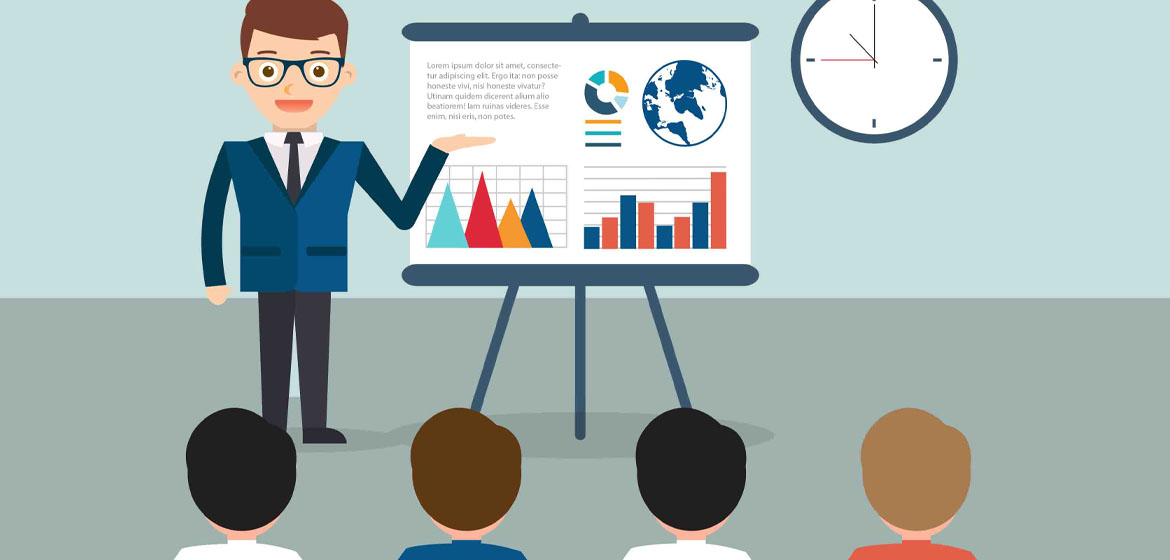Communication is imperative to training. The quality of our communication largely determines ...
How many times have you left a presentation saying to yourself, “Wow, that was great. I wish I could do that! Why can’t I be that good?”
During these series of articles, you will find precise instructions to direct you along the path to presentation excellence.

Communication is imperative to training. The quality of our communication largely determines the quality of our training and our lives. Our communication is constant, whether or not we are speaking. We all, in one way or another, send our messages out to the world, and rarely do we send them consciously. We act out our state of being with nonverbal body language. We lift one eye-brow for disbelief. We rub our noses for puzzlement. We clasp our arms to isolate ourselves or to protect ourselves. We shrug our shoulders for indifference, wink one eye for intimacy, tap our fingers for impatience, and slap our forehead for forgetfulness. The gestures are numerous, and while some are deliberate, many are mostly unconscious.
Have you ever encountered presenters with extremely distracting styles? They pace up and down, exhibit nervous tics, jingle coins in their pocket, use weird gestures. Maybe they have an unusual way of speaking that is hard to understand, or drives you crazy. If so, you were probably not paying attention to the content of what they were saying, and you ended up with a confused or garbled version of their talk. If your tonality or body language does not support the content of your presentation, then your message is unlikely to be heard
Non-Verbal Patterns of Communication
When first presenting and training, people often wonder what to do with their hands. Hands seemed to have a life of their own, and were distracting to us, as well as the audience. Do we put them in our pockets; hold them rigidly down by our sides; hide them behind our backs, clutching a board marker; or do we clasp them modestly in front in the ‘fig leaf’ posture?
Neuro-linguistic programming (NLP) which is the art of excellence in communication found the answers by studying Virginia Satir – the famous family therapist who used a number of category patterns in her routines. She was a family therapist who developed an effective way of working with families. These non-verbal patterns of communication are specific postures and gestures that involve your entire body, including your hands. Each has an accompanying voice tonality.
Each category seems to have cultural associations, so adopting one particular physiology will trigger not only a certain state within you, it will also create a certain state within your audience. They are international; they work across cultures. I know this because I train people from all over the world. Since learning these Satir categories, trainees reported that using these gestures works very successfully in their own countries.

The Satir Gestures -
Here is a brief summary of these five non-verbal communication patterns:
“Leveller”:
Adopt a symmetrical physiology, hands start centrally palms down about waist height moving in an outward direction. As if you are smoothing something (like plaster). This is sending out a very powerful message. Use this sparingly during your presentation in order to make a really important point. Using this gesture at the beginning of your presentation (without saying anything) can also have the effect of people stop talking and start paying attention to you. With Leveler your voice has a falling tonality, and you are slowing down as you do the movement.
Generally Leveler asserts authority and calms people down, so it is very good for bringing things down to earth. When people see that movement and hear that tonality it is as though they are getting the message: “Let me give you the facts. Believe me. This is how things are around here.” When using Leveler, pause at the end of the statement. The unconscious message being send out to your audience is: “This is the way it is”, “This is true”, “Pay attention”, “This is important”, “I know what I am saying”.
“Placater”:
Adopt a symmetrical open physiology with palms turned up or open, moving in an upward or outward direction, like someone pleading for mercy or begging. This should be used rarely in a presentation as this “openness” implied by the gesture can be perceived by your audience as a “weakness” on your behalf. Use it if you want to apologize about something which is your fault. Avoid using it when you convey facts and information as you will not be taken seriously. Unconscious message to your audience: “Help me”, “I’m open”, “I want to please you” or “I’m honest you can trust me”, “I apologize for this mess”.
“Blamer”:
This posture is demonstrated by the pointing finger, jabbing finger and by leaning forward. Warning: this body language can be perceived as very aggressive so use it sparingly. It can be used to point out important issues and procedures that must be followed otherwise the audience will “suffer” serious consequences for not following the procedures. It can be used for motivational purposes during the end of your presentation when you want to inspire your audience or move them to action on a certain matter. Note that when using the pointing or jabbing finger then point above the heads of people. You don’t want to point to anyone during this gesture as this will be taken as rude and inappropriate. Male presenter watch out! If you over use this gesture, you will be perceived by audience members as arrogant. Female presenter warning! If ladies use this gesture a lot then the male audience members will not like the presenter as it could bring back memories of their mother in law or their spouse giving them instructions! Unconscious message to your audience: “It’s your fault” or “It’s down to you”, “Do it this way, or else…”.
“Computer / Thinker”:
To adopt this gesture you have to put one hand on chin with the other arm folded across the chest, hand supporting the elbow. Feet parallel and the hand supports the chin in a closed fist. This is the stance adopted by someone who is thinking, or about to make a decision. Unconscious message to your audience: “I’m the authority”, “I’m reasonable, logical and sensible” or “Here are the facts” or “I have the answers”. Use this gesture when you want to convey facts and information to your audience.

Distracter:
Adopt an asymmetrical physiology, incongruent and off balance weight on one foot etc. Use this gesture if you have a heckler in your audience who tries to annoy you with silly comments or questions. As this is an extreme gesture you should use the Leveler gesture immediately after Distracter. You don’t want the audience members to associate you with the Distracter gesture and not take you seriously. The Distracter gesture can also be performed in a more subtle way by bringing the elbows closer to your body while doing the gesture. With this gesture goes a fluctuating voice, which is distracting because it is unpredictable: high then low; fast then slow. Unconscious message to your audience: “I don’t know”, “It’s not my fault” or “Who cares anyway”.
People will be picking up meaning from this non-verbal communication all the time, and may even be getting more from it than from the presentation itself. The body language you use is a really important part of your telling of the story. Adding the Satir gestures to your presentation will completely transform it; you will find you are communicating far more effectively and this will be reflected upon your audience as they will better understand your message and be more alert during the presentation.
In the next article, I will share with you my knowledge on how to structure/prepare any presentation using a simple format with ease and elegance.



